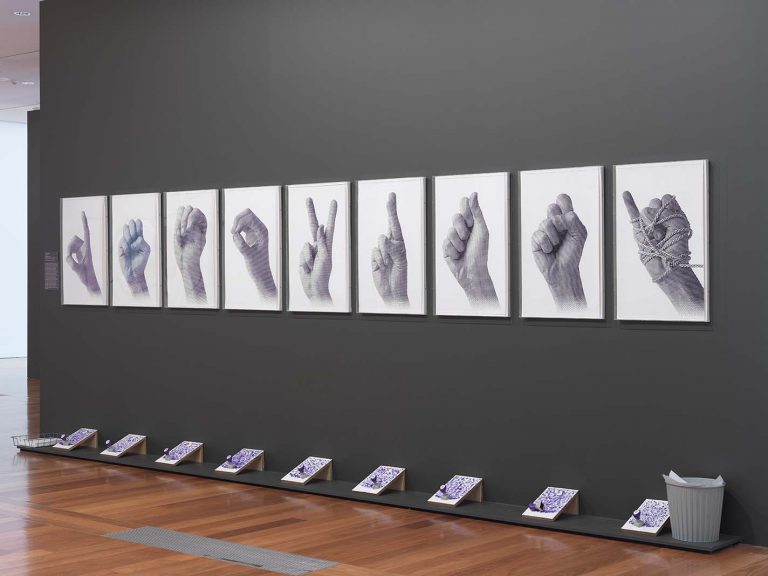We acknowledge the Traditional Owners of the land on which the Queensland Art Gallery | Gallery of Modern Art stands and recognise the creative contribution First Australians make to the art and culture of this country.

FX Harsono / Indonesia b.1949 / Demokrasi (installation view) 1995 / Gelatin silver photographs, wooden stands, self-inking rubber stamps, metal waste paper basket and wire filing tray / Nine photographs: 60 x 50cm (each sheet); 84.3 x 53.6 x 5.4cm (each, framed); installed size variable / Purchased 1995. Queensland Art Gallery Foundation / Collection: Queensland Art Gallery | Gallery of Modern Art / © FX Harsono
FX HarsonoDemokrasi 1995
Not Currently on Display
Jakarta changed radically since becoming the national capital with Indonesian independence in 1945. It is not only the centre of political and economic power, but also of the media. Journalism there is volatile because of the restrictions on reporting the activities of government and financial figures. This sequence of photographs depicting hands spelling out the word ‘democracy’ in sign language, is a plea on behalf of those without a voice. The hand tied with rope, which forms the last letter of the word, suggests how difficult it is to achieve freedom.
For FX Harsono, art is one way of breaking through the silence for people who cannot speak. Being rather disillusioned with art forms which far removed from the real concerns of people’s lives, he often uses his talents as a graphic designer to make art which communicates more strongly and directly than art for art’s sake. Yet Demokrasi is a subtle work with layers of meaning.
By using the hand-language of the deaf, he is able to suggest many things. It is a ‘secret’ language which the majority of people cannot understand. So in this photographic installation, this special code is like a hidden communication between those who must secretly share their hopes for greater freedom. The simplicity of these black and white image is a reminder of the photojournalism of newspapers, which often are not permitted to tell the full story.
For more than 40 years, FX Harsono has been at the centre of Indonesia’s art scene. Harsono advocates for justice within Indonesia by highlighting the ongoing injustices that the Chinese-Indonesian community face in his works, as well as exploring his own lived experience. Along with Javanese heritage, Harsono is also a sixth-generation member of a Chinese immigrant family. Chinese-Indonesians are a minority group who have suffered through a long history of discrimination. By examining his own personal history as a member of a minority group within Indonesia, Harsono addresses issues that concern a global audience.
With a group of young artists, Harsono co-founded of the Gerakan Seni Rupa Baru (also known as the New Art Movement) in 1975. The aim of the New Art Movement is to give a voice to the powerless, something which Harsono has fearlessly advocated for in his works. He continually explores the role of the artist in society, particularly when it comes to uncovering the stories of marginalised groups and presenting a truer version of historical events.